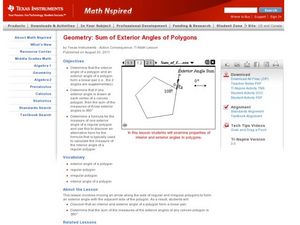Curated OER
Linear Pair Worksheet
For this linear pair worksheet, students use the linear pair theorem to calculate missing angle measurements. This two-page worksheet contains 6 problems. Answers are provided on the last page.
Curated OER
Angle Relationships
Students investigate geometric relationship using conjecture about linear pairs and vertical angles. In this geometry lesson, students apply their theorems and previous geometry knowledge to solve for and find angles of linear pairs....
Curated OER
Linear Pair Theorem
In this linear pair theorem activity, students determine the measure of 6 linear pairs given the measure of one of the pairs.
Curated OER
Linear Equations and Angles
In this geometry worksheet, students identify the length of the different sides using equations. They solve for the unknown to identify similarity and congruence in angles and sides. There are 22 questions.
Curated OER
Angle Relationships
In this angle relationships worksheet, 10th graders solve 7 problems related to the different types of angles that occur in pairs. First, they identify each pair of angles as adjacent, vertical, complementary, supplementary, and/or as a...
Willow Tree
Angles Formed by Transversals of Coplanar Lines
Create a strong understanding of the relationships formed when parallel lines intersect a transversal. Discuss each type of angle pair and their relationship to each other.
Curated OER
Classifying Angles
In this classifying angles worksheet, 10th graders solve and complete 35 various types of problems. First, they match each type of angle with its correct description. Then, students determine whether the given lines or planes are...
EngageNY
Solve for Unknown Angles—Angles and Lines at a Point
How do you solve for an unknown angle? In this sixth installment of a 36-part series, young mathematicians use concepts learned in middle school geometry to set up and solve linear equations to find angle measures.
Curated OER
Angles and Parallel Lines
In this angles and parallel lines worksheet, 10th graders solve 27 different variations of angle types and parallel lines. They name a linear pair, a pair of vertical angles, a pair of complementary angles, and a pair of supplementary...
Curated OER
Angle Relationships
Tenth graders explore the angle relationships that exist when two lines intersect. In this geometry lesson, 10th graders estimate the measure of given angles and use their graphing calculator tools. Students use this knowledge to find...
Virginia Department of Education
Lines and Angles
Explore angle relationships associated with transversals. Pupils construct parallel lines with a transversal and find the measures of the angles formed. They figure out how the different angles are related before constructing...
EngageNY
Writing and Solving Linear Equations
Incorporate geometry into the solving linear equations activity. Pupils use their knowledge of geometry to write linear equations which reinforces geometry measurement concepts while at the same time providing a familiar context for...
Curated OER
Sum of Exterior Angles of Polygons
Have fun calculating angles for different polygons. The class differentiate the relationship between the interior and exterior angles of polygons. They discuss linear pair as it related the polygons and their angles. This is done as they...
Curated OER
Measuring Angles
In this measuring angles worksheet, 10th graders solve and complete 8 various types of problems. First, they use a protractor to find the measure of each angle shown. Then, students find the missing angle measures. They also refer to the...
Curated OER
Naming Angles 2
In this naming angles learning exercise, 10th graders complete 12 problems that identify and name various types of angles in figures. They name a pair of vertical angles and a linear pair in 8 of the problems. Then, students name a pair...
Curated OER
Geometry Lines and Angles
In this lines and angles worksheet, 10th graders solve and complete types of problems that include different line segments and angles to identify. First, they determine whether each line is parallel, skew, or perpendicular in the diagram...
Curated OER
Properties of Angles, Lines, and Triangles
In this properties of angles, lines and triangles instructional activity, 10th graders solve and complete 28 different problems that include determining the measurement of various figures shown. First, they use the geometric properties...
Curated OER
Naming Angles
In this naming angles worksheet, 10th graders solve 12 different problems by responding to each statement defining the angles shown in each box. They name a linear pair in 3 of the problems and name a pair of supplementary angles in 4...
Curated OER
Pairs of Angles Homework
In this algebra worksheet, students identify the missing angles. They use properties of angles, linear pair and vertical angles to find their missing measurement. There are 14 questions.
Curated OER
Intersecting Lines and Vertical Angles
Pupils identify and define intersecting lines and vertical angles. They draw two intersecting lines and measure one pair of vertical angles. Learners will also move a line to change the angles of a figure and describe the changes in the...
Curated OER
Verifying Angle Relationships
In this verifying angle relationships worksheet, 10th graders solve and prove various types of problems related to the verification process of various angle relationships. They complete each of the two proofs shown step-by-step, giving a...
Concord Consortium
In a Triangle
What's in a triangle? Just 180 degrees worth of angles! Young learners use given angle relationships in a triangle to write an algebraic representation. Using a system of equations, they simplify the equation to a linear representation.
Curated OER
Perimeter
Students study about perimeter and the units used to measure perimeter using a variety of materials including their hands, feet, rulers, and computer applets. They understand such attributes as length, area, weight, volume, and size of...
BW Walch
Creating and Graphing Linear Equations in Two Variables
This detailed presentation starts with a review of using key components to graph a line. It then quickly moves into new territory of taking these important parts and teasing them out of a word problem. Special care is taken to discuss...

























